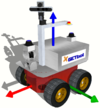Difference between revisions of "Template:Important topics"
| Line 54: | Line 54: | ||
<td valign="top"> | <td valign="top"> | ||
'''[[Three-Angle Representations]]'''<br> | '''[[Three-Angle Representations]]'''<br> | ||
| − | Three angles are enough to describe the orientation of an object in three-dimensional space. But there are two different ways to define these angles, the notation of | + | Three angles are enough to describe the orientation of an object in three-dimensional space. But there are two different ways to define these angles, the notation of [[Roll-Pitch-Yaw|Roll-Pitch-Yaw]] and of [[Euler angles]]. |
</td> | </td> | ||
</tr> | </tr> | ||
</table> | </table> | ||
Revision as of 12:43, 6 May 2015
|
Vector algebra |
|
Matrices |
|
Matrix inversion |
|
Transformations |
|
Three-Angle Representations |




